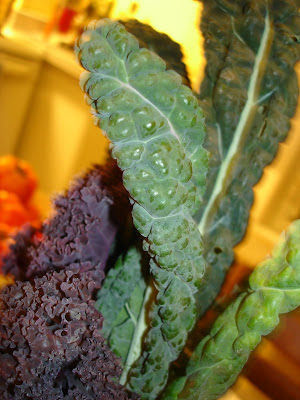Canada's next top model....

 Kale is such a beautiful vegetable that I couldn't help myself from having a veritable photo session with the frilly greens!
Kale is such a beautiful vegetable that I couldn't help myself from having a veritable photo session with the frilly greens!As its dark colours can attest, kale is a real nutritional powerhouse, unfortunately, it isn't a well liked vegetable. Which is bizarre, because as far as green vegetables go, it isn't particularly strong flavoured (like cabbage), bitter (like rapini) or tongue rasping (like swisschard). No, I can't really figure out why so many people back away from this lovely green.


It is a most forgiving vegetable: first of all, it keeps for a ridiculously long time -these babies have been waiting in a plastic bag, out in my garden shed for close to a month, and th
 ey are still full of life! Secondly, they are one of the few vegetables that can take any amount of cooking. In fact, kale likes to be well done.
ey are still full of life! Secondly, they are one of the few vegetables that can take any amount of cooking. In fact, kale likes to be well done.Unlike most other greens that are best eaten underdone, kale is actually more palatable if it is thoroughly cooked (6-10 minutes in boiling water), and cooked some more (drained, rinsed, then thrown in a pan with butter, or in some tomato sauce, or reheated with leftover mashed potatoes....) Indeed, if you like to have green bits in your stews and casseroles, kale is the veg for you: it will be more than happy to stew for a couple of hours in a C
 rockpot or braise in the oven with whatever you want. The green kales may lose some of their brightness, but they will not turn muddy like, say, swisschard.... and the purple and pink kales will pretty much keep their hues.
rockpot or braise in the oven with whatever you want. The green kales may lose some of their brightness, but they will not turn muddy like, say, swisschard.... and the purple and pink kales will pretty much keep their hues.Kale, like many of its kissing cousins in the cabbage family, is a very hardy vegetable: you may have noticed pretty, pink cabbages in some gardens, frosted over or even covered in snow. Although these decorative kales were bred for their colours, they are actually edible, and repeated frosts and snow cover renders them more digestible (just like Brussel sprouts!) This hardiness makes it the ideal winter vegetable for our northern climate: it is, in theory, available until at least late February, however its low popularity makes it sometimes hard to find locally. I have seen imported kale at the supermarket, but they tend to come from warmer climes and are sometimes tough because they were not subjected to frost. If you must buy imported kale, cook it 'to death' or place in the freezer before eating.
Better yet, if you have room for a couple of planters, plant some kale by your door step. It'll make a beautiful, seasonal display, and subjected to the frosty winds and snow, it will provide you with several tasty meals!
 You may recall my raving-ons about beet purée. Well here it is in all its glory: pan seared giant scallops on a bed of buttered kale and a lovely beet purée.
You may recall my raving-ons about beet purée. Well here it is in all its glory: pan seared giant scallops on a bed of buttered kale and a lovely beet purée.Bon app'!



Hi there! I recently stumbled across your blog, I work for Foodista.com and I not sure if you have heard but we just announced a call for submissions for a food blogger cookbook contest this week!
ReplyDeleteFor the next three months, food bloggers can submit their photography, writings, and original recipes to Foodista.com. The public can view all submissions on the website and vote for their favorites. That feedback and editors at both Andrews McMeel Publishing and Foodista.com will determine 100 entries chosen for inclusion in "The Foodista Best of Food Blogs Cookbook." More info available here: http://www.foodista.com/blogbook.
You should totally enter this post!
Good Luck!
You've got a great blog- and a great chance to win.